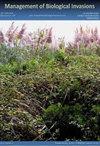法兰德斯(比利时北部)不同Larson陷阱诱捕埃及鹅的效果试验
IF 1.5
4区 环境科学与生态学
Q3 BIODIVERSITY CONSERVATION
引用次数: 2
摘要
在西欧,埃及鹅被认为是传播最快的入侵鸟类之一。被欧盟列为欧盟关注的物种,受到限制和措施,并敦促欧洲成员国制定管理策略。由于射击、诱捕换毛和控制虫卵等常用技术已不足以降低种群数量,因此对替代有效控制策略的需求很高。在这里,我们报告了现场试验,测试了使用活诱饵鸟的移动式陷阱。试验持续了数年,以确定最佳捕集季节和捕集器设计,并探索不同的部署方案。我们发现比利时的繁殖期是设置陷阱的最佳季节,这表明地域反应是陷阱效率的主要驱动因素。在捕捉埃及鹅方面,陆基设计的效果明显好于其他类型的陷阱,而且副渔获量要少得多。在不同地点以短间隔部署陷阱的策略效率最高。我们得出的结论是,当大规模使用这种诱捕器并在繁殖之前诱捕成年鸟类时,使用这种诱捕器的陆基版本可以成为更广泛的管理策略的有用补充。考虑到这种诱捕需要付出很大的努力和其他管理技术的预期效果,该方法最好与繁殖后射击相结合。KVM:研究概念,样本设计和方法,调查和数据收集,写作-审查和编辑。本文章由计算机程序翻译,如有差异,请以英文原文为准。
Testing the efficacy of different Larson trap designs for trapping Egyptian geese (Alopochen aegyptiacus L.) in Flanders (northern Belgium)
In Western Europe, the Egyptian goose is considered one of the most rapidly spreading invasive bird species. Listed as a species of Union Concern by the EU, it is subject to restrictions and measures and European Member States are urged to develop management strategies. Since common techniques such as shooting, moult trapping and egg control have been inadequate at lowering population numbers, there is a high demand for alternative effective control strategies. Here, we report on field trials testing the use of walk-in traps with live decoy birds. Trials were spread out over several years to establish optimal trapping season and trap design and to explore different deployment options. We found that in Belgium the breeding period was the optimal season for deploying traps, which suggests the territorial response is the main driver of trapping efficiency. Land-based designs performed significantly better than other trap types at catching Egyptian geese and had far fewer by-catches. The strategy in which traps were deployed at short intervals over various locations had the highest efficiency. We conclude that the use of land-based versions of this trap type can be a useful addition to a wider management strategy when used on a large scale and aimed at trapping adult birds prior to breeding. Given the high effort needed for this type of trapping and the expected effectiveness of other management techniques, the method is best combined with post breeding shooting. KVM: research conceptualization, sample design and methodology, investigation and data collection, writing – review and editing.
求助全文
通过发布文献求助,成功后即可免费获取论文全文。
去求助
来源期刊

Management of Biological Invasions
Agricultural and Biological Sciences-Ecology, Evolution, Behavior and Systematics
CiteScore
3.40
自引率
6.70%
发文量
21
审稿时长
16 weeks
期刊介绍:
Management of Biological Invasions, established in 2010 by Dr. Elias Dana, is an open access, peer-reviewed international journal focusing on applied research in biological invasions in aquatic and terrestrial ecosystems from around the world. This journal is devoted to bridging the gap between scientific research and the use of science in decision-making, regulation and management in the area of invasive species introduction and biodiversity conservation.
Managing biological invasions is a crisis science, with Management of Biological Invasions aiming to provide insights to the issues, to document new forms of detection, measurements and analysis, and to document tangible solutions to this problem.
In addition to original research on applied issues, Management of Biological Invasions publishes technical reports on new management technologies of invasive species and also the proceedings of relevant international meetings. As a platform to encourage informed discussion on matters of national and international importance, we publish viewpoint papers that highlight emerging issues, showcase initiatives, and present opinions of leading researchers.
 求助内容:
求助内容: 应助结果提醒方式:
应助结果提醒方式:


